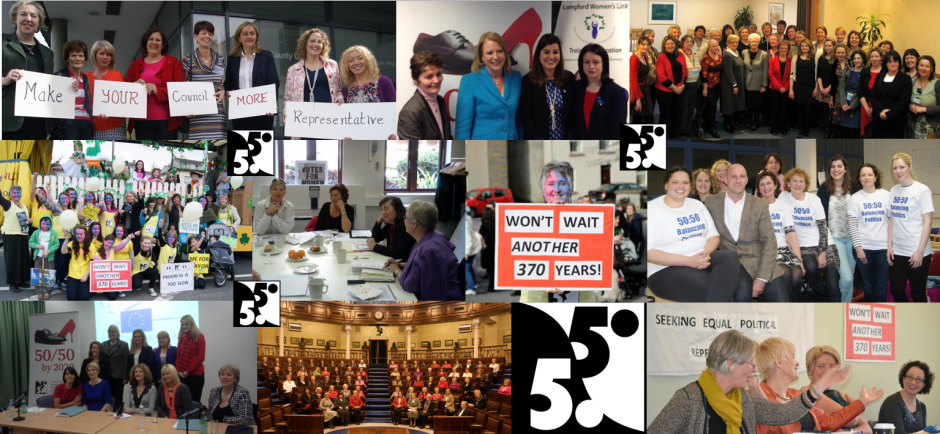Fiona Buckley, Department of Government, University College Cork & The 50/50 Group
- Only 25 of 166 Dáil seats are held by women (15.25%)
- Ireland occupies 79th position of 133 nation-states in IPU rankings
- Ireland is in 22nd place amongst 27 EU member states
- Of 4,744 Dáil seats filled since 1918, only 260 (5.48%) have been occupied by women
- Only 91 women have been elected to Dáil Éireann since foundation of the State
- 181 people served in cabinet in Ireland since 1922, 12 (7%) have been women
- With 15.25% female representation in lower house of parliament, Ireland is behind both world average 19.5 % & European Union average 24%
- Seanad – 18 of 60 seats (30%) are held by women – only 86 women have served in Seanad
- Women account for 17% of members of local authorities & just 12% of members of regional authorities
- 86 women out of 564 candidates contested 2011 General Election – lowest number of women candidates to contest a General Election since 1989
- In 21 of 43 constituencies – there are no women TDs
- National Women’s Council of Ireland estimated that, at present rate, it will take 370 years before gender parity in political representation is achieved in Ireland
“Irish political culture remains embarrassing because of its maleness and the contempt it continues to show towards women” (Diarmuid Ferriter: 2011)
Mary Robinson:
“A society that is without the voice and vision of a woman is not less feminine. It is less human.”
______________________________________
Barriers to women’s participation in Irish Politics
There are 5 ‘C’s :
- Care (childcare & other)
- Cash
- Candidate selection
- Culture
- Confidence
Do women face discrimination from Irish voters?
No – say White (2006); Buckley, Collins & Reidy (2007); Marsh & McElroy (2010); Buckley & McGing (2011)
No – say White (2006); Buckley, Collins & Reidy (2007); Marsh & McElroy (2010); Buckley & McGing (2011)
But:
- NWCI survey of 2009 Local Elections – some female candidates subjected to sexist comments
- O’Kelly (2000) found evidence of bias against women candidates in Irish political parties
________________________________________
Electoral ‘Gender’ Quotas
- Act as a process of change & facilitator of women’s political inclusion
- Compensate for many gendered barriers to accessing political office
Implementation - Constitutional approach (e.g. France, Rwanda)
- Legislative approach (e.g. Belgium, Spain, Poland, Argentina)
- Voluntary approach (e.g. Scandinavian countries; Germany)
Application
- Results /Outcome (Reserve Seats)
- Nomination (Candidate Selection) – this is proposed in Ireland
_______________________________
Why Quotas? Background
- Legacy of
(i) historical exclusion of women from political citizenship (ie suffrage)
(ii) bias towards traditional gender roles have resulted in women’s under-representation worldwide
_______________________________
Quotas – things to consider
Questions about quotas:
Do ‘gender quotas’ work?
- 17 of the top 20 nations, in terms of women’s political representation, have gender quotas
- Incremental progress rather than fast-track changes
How is the quota enforced & monitored? - Sanctions for non-compliance must be effective
Financial penalties; list rejections ; disqualifications; strong leadership; monitoring
Are gender quotas democratic/fair?
Liberals say ‘no’ but others say they are compensatory & promote democracy
Are gender quotas democratic/fair?
Liberals say ‘no’ but others say they are compensatory & promote democracy
What about the ‘merit’ debate?
- Naïve to assume all politicians make it on merit alone
- What of family dynasties; the ‘GAA’ or ‘celebrity’ candidate; differing access to funding
What about the ‘token’ or ‘quota woman’ debate?
_____________________________
Electoral (Amendment) (Political Funding) Bill 2011
- Proposes that half of state funding of political parties be contingent on at least 30% of candidates being women & at least 30% being men
- Quota to rise to 40% after 7 years
- Only applies at General Elections.; why not Local Government?
- Why wait 7 years to raise quota; why not sooner?
- Why 30% initially; why not higher?
- Why a legislative quota now?
- Lack of progress; static development; Government policy
- But have other strategies been used? Yes, but these have not been effective (see Claire McGing presentation)
- Lack of party leadership & commitment
- Where will the political parties ‘find’ women candidates?
- Draw from their membership – Women party members DO exist!!
Fine Gael: 42%; Labour: 37%; FiannaFáil: 34% & Sinn Féin: 24% - Head-hunt
- Change selection processes – have all- women shortlists at nomination stage ?
When will we see changes?
Takes at least 3 electoral cycles before an impact on women’s descriptive representation is seen
We must expand the level of female representation from civil to political sphere!!
_____________________________
- Quotas provide an opportunity structure to facilitate women’s electoral candidacy (access to the ballot paper)
- Quotas provide voters with greater electoral choice ((i) option to choose between men & women & (ii) between women of different parties
- Ireland’s record in relation to women’s political representation is a travesty of democracy
If not quotas, what is the alternative? If not now – when?
